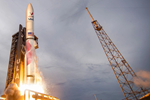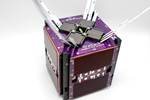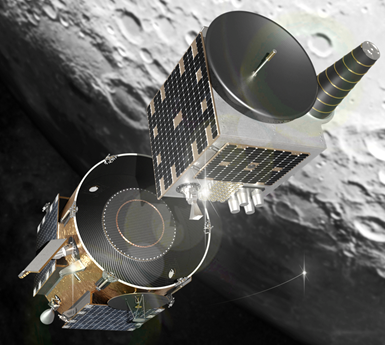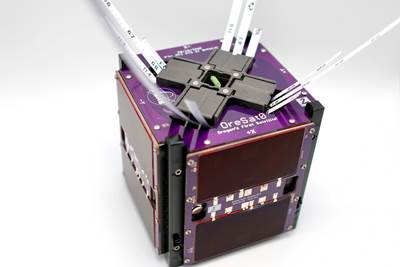NASA selects Firefly Aerospace for lunar surface payloads
Two agency payloads are targeted to launch in 2026 to a landing site on the far side of the moon to gain a better understanding of the early evolution of the universe.
Rendering of Firefly’s Blue Ghost transfer vehicle deploying the ESA’s Lunar Pathfinder satellite to lunar orbit. Photo Credit: Firefly Aerospace
To carry multiple payloads to the far side of the moon, including a satellite to orbit that area, NASA (Washington, D.C., U.S.) has awarded a contract to Firefly Aerospace (Cedar Park, Texas, U.S.) for just under $112 million to deliver two agency payloads, as well as communication and data relay satellite for lunar orbit, a European Space Agency (ESA) collaboration with NASA. The commercial lunar delivery targeted to launch in 2026 is NASA’s Commercial Lunar Payload Services (CLPS) initiative, and is part of the agency’s Artemis program.
This delivery targets a landing site on the far side of the moon for the two payloads, a place that permanently faces away from Earth. Scientists consider this one of the best locations in the solar system for making radio observations shielded from the noise generated by our home planet. The sensitive observations need to take place during the 14 earth-day long lunar night.
One of these payloads delivered to the lunar surface aims to take advantage of this radio-quiet zone to make low-frequency astrophysics measurements of the cosmos — focusing on a time known as the “Dark Ages,” a cosmic era that began some 370,000 years after the Big Bang and lasted until the first stars and galaxies formed. Since there is no line of sight and no direct communication with Earth from the far side of the moon, Firefly also is required to provide communication services.
“NASA continues to look at ways to learn more about our universe,” says Nicola Fox, associate administrator, science mission directorate at NASA headquarters in Washington. “Going to the lunar far side will help scientists understand some of the fundamental physics processes that occurred during the early evolution of the universe.”
Firefly is responsible for end-to-end delivery services, including payload integration, delivery from Earth to the surface and orbit of the moon and NASA payload operations for the first lunar day. This is the second award to Firefly under the CLPS initiative. This award is the ninth surface delivery task award issued to a CLPS vendor, and the second to the far side.
The three payloads slated for delivery are expected to weigh in total about 1,090 pounds (494.5 kilograms). These payloads are:
- Lunar Surface Electromagnetics Experiment-Night (LuSEE-Night): A pathfinder to understand the moon’s radio environment and to potentially take a first look at a previously unobserved era in our cosmic history. It will use deployable antennas and radio receivers to observe sensitive radio waves from the Dark Ages for the first time. LuSEE-Night, is a collaboration between the Department of Energy’s (DOE) Brookhaven National Laboratory, the University of California, Berkeley, Space Science Laboratory and NASA’s Science Mission Directorate. It is managed for NASA by the Planetary Missions Program Office at NASA’s Marshall Space Flight Center in Huntsville, Alabama.
- Lunar Pathfinder: A communications and data relay satellite that will provide communication services to lunar missions via S-band and UHF links to lunar assets on the surface and in orbit around the moon and an X-band link to Earth. ESA’s Lunar Pathfinder is designed and developed by Surrey Satellite Technology Limited. ESA collaborated with NASA for delivery through the CLPS initiative.
- User Terminal (UT): This payload will institute a new standard for S-Band Proximity-1 space communication protocol and establish space heritage. It will be used to commission the Lunar Pathfinder and ensure its readiness to provide communications service to LuSEE-Night. It consists of software-defined radio, an antenna, a network switch and a sample data source. UT is in development by NASA’s Jet Propulsion Laboratory in Southern California.
Commercial deliveries to the lunar surface with several providers continue to be part of NASA’s exploration efforts. Future CLPS deliveries could include more science experiments and technology demonstrations that further support the agency’s Artemis program.
Learn more about Firefly Aerospace’s capabilities for space applications, including the company’s composites-intensive Alpha 2.0 launch vehicle, and a medium launch vehicle developed in collaboration with Northrop Grumman.
Related Content
Materials & Processes: Fibers for composites
The structural properties of composite materials are derived primarily from the fiber reinforcement. Fiber types, their manufacture, their uses and the end-market applications in which they find most use are described.
Read MoreCarbon fiber in pressure vessels for hydrogen
The emerging H2 economy drives tank development for aircraft, ships and gas transport.
Read MorePlant tour: Joby Aviation, Marina, Calif., U.S.
As the advanced air mobility market begins to take shape, market leader Joby Aviation works to industrialize composites manufacturing for its first-generation, composites-intensive, all-electric air taxi.
Read MoreMaterials & Processes: Composites fibers and resins
Compared to legacy materials like steel, aluminum, iron and titanium, composites are still coming of age, and only just now are being better understood by design and manufacturing engineers. However, composites’ physical properties — combined with unbeatable light weight — make them undeniably attractive.
Read MoreRead Next
Beyond Gravity to supply ULA with composite payload fairings, adds to Amazon satellite contract
Beyond Gravity will deliver 38 carbon fiber payload fairings, in addition to Amazon CFRP dispenser contract, for Project Kuiper, expands U.S. production facility capacity.
Read MoreWindform LX 3.0 composites contribute to OreSat0 CubeSat deployment
Portland State Aerospace Society, incorporating CRP Technology’s GFRP composite materials and SLS 3D printing, sent its CubeSat nanosatellite into low Earth orbit in 2021, where it continues to operate successfully.
Read MoreCW’s 2024 Top Shops survey offers new approach to benchmarking
Respondents that complete the survey by April 30, 2024, have the chance to be recognized as an honoree.
Read More

















.jpg;maxWidth=300;quality=90)









